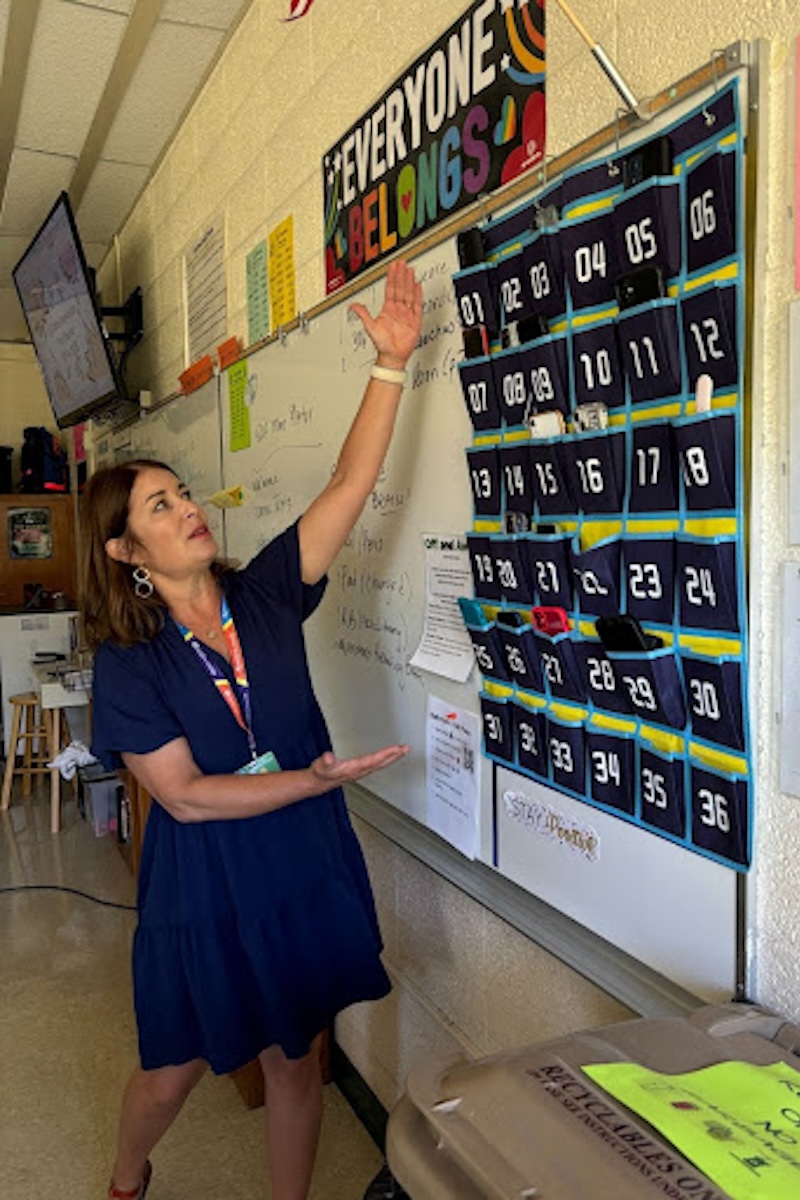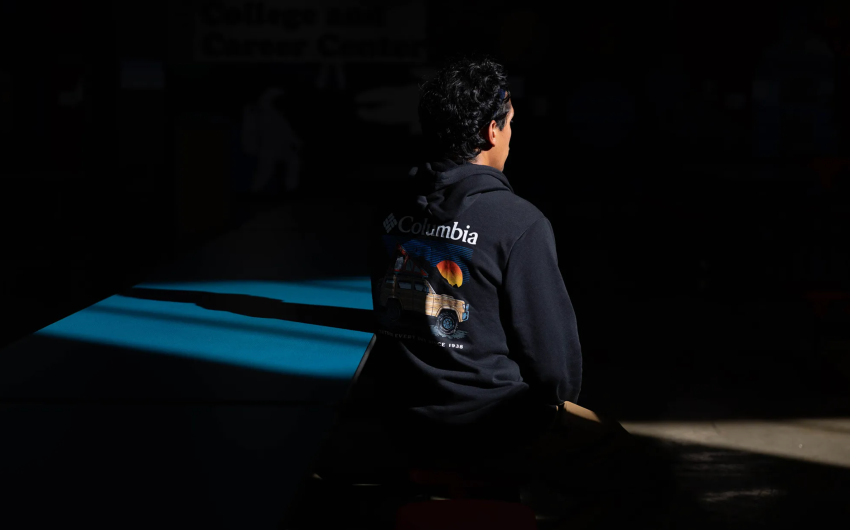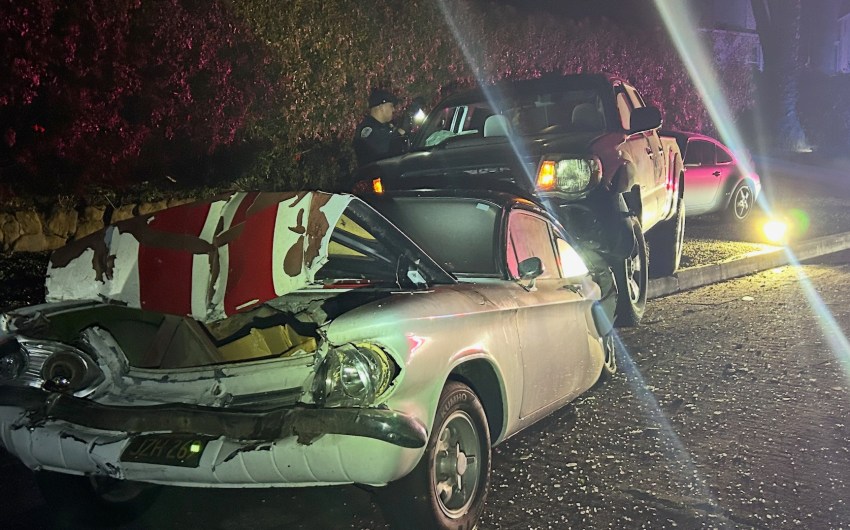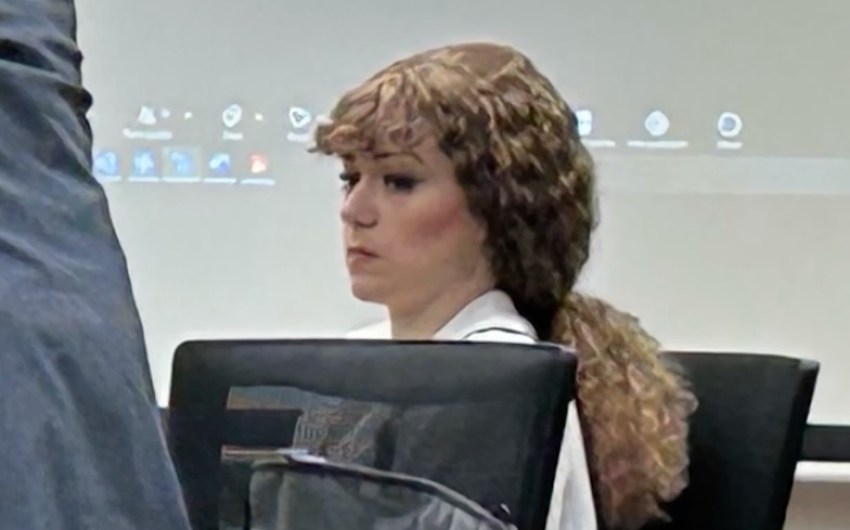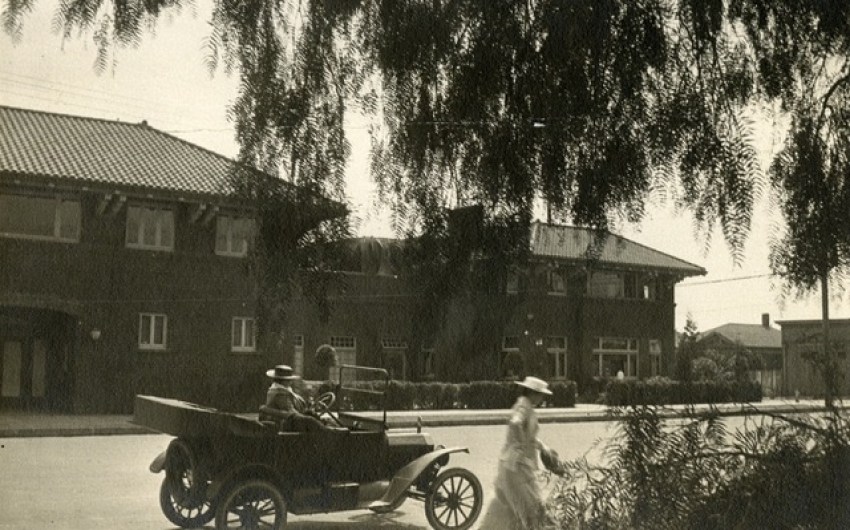Many teenagers, at no fault of their own, are addicted to their smartphones. But teachers across the Santa Barbara Unified School District are done competing with screens for their students’ attention.
On Monday, high school students began this school year by checking their phones into “cell hotels.” Whether these hotels are charging stations, clear boxes, or a pocket chart, they take the handheld distractions out of reach of students in the classroom.
Although enforcing these policies is easier said than done, phones across the district are going “Off and Away,” a rule the Santa Barbara Teachers Association (SBTA) came up with a few years ago. It was born from discussions with the district about the impact of cell phone use on instruction, student engagement, and classroom management.
“We saw the negative impact devices were having on our students and knew we needed a change,” said SBTA leadership. “The more the policy is supported system-wide, the more benefits we’ll see for students.”
The policy is implemented across grade levels, but this year, it evolved at the high schools.
San Marcos High School was the first to adopt a schoolwide hotel policy to create consistency across classrooms, where teachers’ methods previously varied and still vary at other grade levels. Some employed hotels, while others would only require the phones to be off and out of sight.
Enforcing the policy consistently was tricky, with some teachers struggling more than others to keep students on task. Teachers reported students lying about having a phone, or putting other things in the hotels to try to trick them.
The district’s three high school principals, however, recognized the breadth of research showing the effect that phones have on students’ ability to focus, their grades, and their declining mental health, with higher screen times related to greater risks of developing symptoms of anxiety and depression.
The principals met last year and figured, “Maybe we should all do cell hotels,’” said Dos Pueblos Principal Bill Woodard. This year, hotels will be implemented schoolwide at all three high schools. They hope it sends the message that instruction is the top priority in the classroom.
“If that phone is pinging in your pocket, it can take you up to 20 minutes to refocus,” Woodard said.
According to a 2023 study by Common Sense Media, the average student receives 60 notifications and spends roughly 43 minutes — the length of a class period — on their phone during the school day.
Woodard said that most kids know it’s a problem, and understand the “why” behind the cell hotels. “It’s making students realize and rethink their relationship with technology,” Woodard said. “We’re an educational institution reckoning with the mix of positive and negative effects tech has had on learning. The evidence is in; now it’s what we do about it.”
If students repeatedly break the rules — after a few trips to the office — Woodard said students won’t be allowed to bring their phones at all, which a few parents already requested.
However, Woodard also recognized the “undercurrent of school violence” across the country. In emergencies, students will be allowed to have their phones. Additionally, students with special needs, such as those with diabetes who use their phones to track their insulin levels, will be exceptions to the rule. When students are in class, parents can reach them by calling the front office.
Assistant Superintendent ShaKenya Edison said schoolwide cell hotels are starting to gain traction districtwide. And it’s not just phones — it includes headphones, smartwatches, and other tech, too.
But Santa Barbara and many other districts have realized that to successfully detach students from their cell phones, they must get to the heart of the issue. Edison said they are treating phone use as addiction, not defiance.
“We are trying to tackle the physical effect of phones in hand, but also the mental element,” she explained. “We’re helping students identify why they are pulling out their phones, whether that’s social anxiety, or stress over an assignment they’re working on. We’re asking, ‘What are they escaping?’ to help them move toward self-management.”
The Off and Away policy was not only the result of teachers’ complaints about distractions, but also parents sharing the same experiences at home. To really address the issue, Edison said the district took an “all-systems” approach, involving parents, students, and pediatricians, and sharing resources to monitor screen use outside the classroom.
“We have students for 180 days, but they are part of the community [for] 365,” she said.
Schools across the state are now banning phones in the classroom, especially in the wake of a 2019 law allowing such bans and a letter from Governor Gavin Newsom last week urging school districts to restrict phone use in classrooms as the new academic year begins — in it, Newsom even applauded Santa Barbara Unified.
“Schools and districts, including Santa Barbara Unified and Bullard High in Fresno, have seen positive impacts of limiting smartphones on campus, with some reporting higher test scores, grades, and student engagement, and less bullying and damage to school facilities,” wrote Governor Newsom.
Edison confirmed this, saying students are more engaged, and parents are “receptive and appreciative.” However, they are still monitoring whether the policy will have a positive affect on academic performance as well.
In preparation for the new school year, principals throughout Santa Barbara Unified are communicating with their families to share policies and expectations for students. Woodard said parents are “pleased overall” with the policy, but he’s still waiting to hear from students.
“We’ll see when we start having grade-level assemblies — I might get booed,” he laughed.
Premier Events
Wed, Dec 31
9:00 PM
Santa barbara
NEW YEAR’S Wildcat Lounge
Fri, Dec 26
7:00 AM
Solvang
Solvang Julefest
Sat, Dec 27
7:00 PM
Santa Barbara
Schnack ‘n Bari Jazz Trio at Roy
Wed, Dec 31
6:15 PM
Santa Barbara
NYE 2026 with SB Comedy Hideaway!
Wed, Dec 31
9:00 PM
Santa barbara
NEW YEAR’S Wildcat Lounge
Wed, Dec 31
10:00 PM
Santa Barbara
In Session Between Us: Vol. I NYE x Alcazar
Wed, Dec 31
10:00 PM
Santa Barbara
NYE: Disco Cowgirls & Midnight Cowboys
Thu, Jan 01
7:00 AM
Solvang
Solvang Julefest
Thu, Jan 01
11:00 AM
Santa Barbara
Santa Barbara Polar Dip 2026
Sat, Jan 03
8:00 PM
Santa Barbara
No Simple Highway- SOhO!
Sun, Jan 04
7:00 AM
Solvang
Solvang Julefest
Wed, Dec 31 9:00 PM
Santa barbara
NEW YEAR’S Wildcat Lounge
Fri, Dec 26 7:00 AM
Solvang
Solvang Julefest
Sat, Dec 27 7:00 PM
Santa Barbara
Schnack ‘n Bari Jazz Trio at Roy
Wed, Dec 31 6:15 PM
Santa Barbara
NYE 2026 with SB Comedy Hideaway!
Wed, Dec 31 9:00 PM
Santa barbara
NEW YEAR’S Wildcat Lounge
Wed, Dec 31 10:00 PM
Santa Barbara
In Session Between Us: Vol. I NYE x Alcazar
Wed, Dec 31 10:00 PM
Santa Barbara
NYE: Disco Cowgirls & Midnight Cowboys
Thu, Jan 01 7:00 AM
Solvang
Solvang Julefest
Thu, Jan 01 11:00 AM
Santa Barbara
Santa Barbara Polar Dip 2026
Sat, Jan 03 8:00 PM
Santa Barbara
No Simple Highway- SOhO!
Sun, Jan 04 7:00 AM
Solvang

